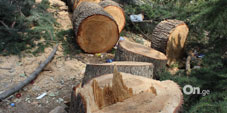
Questions about the trees cut in Tbilisi
By Tea Mariamidze
Wednesday, January 11
A Non-Governmental Organization (NGO), Institute for Development Freedom of Information, says that in 2016, five times more trees were diagnosed as “ill” by the Mayor’s Office of Tbilisi.
The NGO says that recently increased statistics of ill trees raises questions how thoroughly the diagnosing process is being carried out.
The IDFI provided information according to which in 2013-2016, a total of 583 permissions were issued by the Mayor’s Office and 3,552 trees were cut down. However, only 827 trees were truly at risk.
The information also reveals that including August 2016, the number of ill trees in Tbilisi increased 5 times, compared to the previous years.
“This circumstance raises question how decently the trees are diagnosed in the capital, especially when the NGOs revealed the fact of cutting healthy trees in summer,” the NGO reports.
The IDFI says that by issuing permits on tree cutting, the Mayor’s Office of Tbilisi totally received GEL 1.947282 income. The highest annual income 666,778 Gel was observed in 2016.
As for the construction permissions, in 2011-2016 total 1747 permits were issued by the Mayor’s Office, for the construction of residential buildings and multi-unit facilities.
The most construction permits were issued in 2011. However, the NGO underlined that in 2016-2017 the growing tendency of issuing construction permits has been observed.
The IDFI also says that the m2 construction company applied to Parliament on December 15 2016, asking to abolish fees for cutting down dying and damaged trees.
“In 2014-2016, m2 received permission to cut 94 trees in the capital, and only 4 trees out of them were dying,” the NGO stressed.
The IDFI believes that if Parliament adopts amendments to the law, requested by m2, this might be followed by some serious consequences.
Construction companies might damage trees themselves in order to avoid paying fees, which will reduce income received by tree cutting. Also, corruption risks might emerge in the mayor’s office during the process of tree-diagnosing.
The NGO says that the fields of construction of tree cutting should be properly defined and observed in order to avoid further risks and negative consequences.


